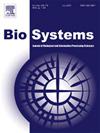运动细菌不断增长的模型中的固定周期模式
IF 1.9
4区 生物学
Q2 BIOLOGY
引用次数: 0
摘要
生物模式的形成是自然界最有趣的现象之一。简单的例子包括行波和固定周期模式,它们出现在各种生物过程中,包括形态发生和种群动态。在许多实验研究中已经证明,这种模式在盘状盘基架菌和大肠杆菌等活动微生物种群中出现。在包含扩散和平流项的动力系统的数学研究中,通常探讨不同类型的模式形成所需的条件。在这项工作中,我们引入了一个原型模型,用于不断增长的可移动细菌群体,这些细菌会对化学信号做出反应。我们对该模型进行线性分析,以确定形成平稳周期图案的条件,然后进行非线性(傅立叶)分析,以表征其特性,如振幅和波长。通过数值模拟进一步验证了我们的分析结果。本文章由计算机程序翻译,如有差异,请以英文原文为准。
Stationary periodic patterns in a model of growing population of motile bacteria
Biological pattern formation is one of the most intriguing phenomena in nature. Simple examples include travelling waves and stationary periodic patterns, which arise in various biological processes, including morphogenesis and population dynamics. The emergence of such patterns in populations of motile microorganisms, such as Dictyostelium discoideum and E. coli, has been demonstrated in numerous experimental studies. The conditions required for different types of pattern formation are commonly explored in mathematical studies of dynamical systems incorporating diffusion and advection terms. In this work, we introduce a prototype model for a growing population of motile bacteria that move in response to a chemical signal. We conduct a linear analysis of this model to determine the conditions for the formation of stationary periodic patterns, followed by a nonlinear (Fourier) analysis to characterise their properties, such as amplitude and wavelength. Our analytical findings are further validated through numerical simulations.
求助全文
通过发布文献求助,成功后即可免费获取论文全文。
去求助
来源期刊

Biosystems
生物-生物学
CiteScore
3.70
自引率
18.80%
发文量
129
审稿时长
34 days
期刊介绍:
BioSystems encourages experimental, computational, and theoretical articles that link biology, evolutionary thinking, and the information processing sciences. The link areas form a circle that encompasses the fundamental nature of biological information processing, computational modeling of complex biological systems, evolutionary models of computation, the application of biological principles to the design of novel computing systems, and the use of biomolecular materials to synthesize artificial systems that capture essential principles of natural biological information processing.
 求助内容:
求助内容: 应助结果提醒方式:
应助结果提醒方式:


